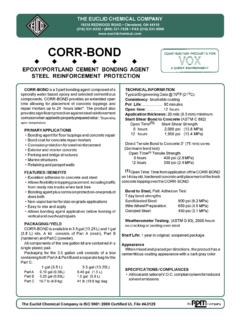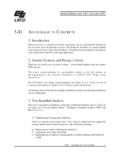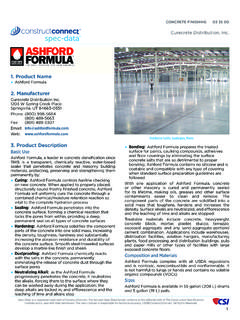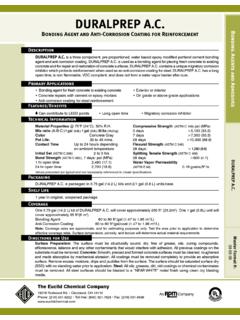Transcription of USE OF POLYMER CONCRETE IN CONSTRUCTION
1 USE OF POLYMER CONCRETE IN CONSTRUCTION *SK Gupta **Mahesh Kumar ABSTRACT POLYMER CONCRETE (PC) is a composite material in which the binder consists entirely of a synthetic organic POLYMER . It is variously known as synthetic resin CONCRETE , plastic resin CONCRETE or simply resin CONCRETE . Because the use of a POLYMER instead of portland cement represents a substantial increase in cost, polymers should be used only in applications in which the higher cost can be justified by superior properties, low labor cost or low energy requirements during processing and handling. It is therefore important that architects and engineers have some knowledge of the capabilities and limitations of PC materials in order to select the most appropriate and economic product for a specific application.
2 Introduction As we are becoming more and more cautious of conservation of energy and materials, interest has grown in improving the strength, toughness, ductility and durability of portland cement CONCRETE or in finding an alternative material that exhibits superior properties and is cost effective. Polymers are a large class of materials consisting of many small molecules (called monomers) that can be linked together to form long chains, thus they are known as macromolecules. A typical POLYMER may include tens of thousands of monomers. Because of their large size, polymers are classified as macromolecules. Humans have taken advantage of the versatility of polymers for centuries in the form of oils, tars, resins, and gums 1. Classification of POLYMER - CONCRETE Materials Significant progress has been made recently in both fundamental and applied research on all kinds of POLYMER / CONCRETE system.
3 There exist three principal classes of POLYMER CONCRETE materials viz., (a) POLYMER - portland cement CONCRETE (PPCC), (b) POLYMER impregnated CONCRETE (PIC) and (c) POLYMER CONCRETE (PC). POLYMER portland cement CONCRETE (PPCC) A monomer, prepolymer of dispersed POLYMER is incorporated into a portland cement mix and a POLYMER network formed in situ during curing of the CONCRETE . POLYMER -Impregnated CONCRETE (PIC) Previously formed CONCRETE is impregnated with a monomer which is subsequently polymerized in situ. Polymers enhances the Strength Characteristics of the original CONCRETE . _____* Associate Professor, NITTTR, Chandigarh ** Engineer-in-Chief, Public Works (B&R) Department, Haryana ,Chandigarh and Senior Vice President, Indian Buildings Congress POLYMER CONCRETE (PC) It is also known as Resin CONCRETE .
4 A POLYMER is used to bind an aggregate together. 2. POLYMER portland cement CONCRETE Typical vinyl monomers such as methyl methacrylate or styrene either interfere with .the hydration of the cement or degraded by the high alkalinity present. Prepolymers such as polyester-styrene and epoxies can be effective, though fairly high proportions are usually required if mechanical properties are to be improved. Most attention has been given to the incorporation of a polymeric latex. Emulsion lubricates the mix, less water is usually needed for workability. In fact, POLYMER latexes-usually of acrylics, Styrene utadiene, copolymers, poly (vinylidene-chloride) epoxies and poly (vinyl esters)have been used in mortars and concretes for' about 45 years. In general, latex-type POLYMER - portland cement CONCRETE exhibit excellent bonding to steel reinforcement and to old CONCRETE , good ductility, resistance to penetration by water and salt and excellent durability to freezing and thawing.
5 Several factors are apparently involved in improving properties, the reduction in water- cement ratio and hence in the volume of capillary porosity. More specifically, the following requirements for the POLYMER are required:- a) The latex must be able to form a film under ambient conditions, to coat cement grains and aggregate particles and to form a strong bond between the cement matrix and the aggregate. b) The POLYMER network must possess the capacity to intercept a growing micro rack and by dissipating energy through micro fibril formation hinder crack preparation. Actually bonding between Ca++ions and POLYMER appears to exist. The latex particles coat the cement gel and aggregate surfaces with a monolayer. The most common applications have been in mortars, patching compounds, flooring and over lays for bridge decks, The most common latex systems have been based on copolymers of styrene-butadiene, vinylidene chloride and acrylics.
6 The use of self-emulsifying epoxies is also of current interest. a) More is to be known about the interfacial chemistry, curing phenomena, fire resistance and stablization or degradation mechanism. b) Much more needs to be known about mechanical behaviour, fracture toughness, fatigue resistance and creep. c) Cost-effectiveness needs to be carefully estimated in a objective manner. 3. POLYMER Impregnated CONCRETE : The general principles, required for impregnation and polymerization 'of' monomers in situ are now reasonably well established provided that most of the water is removed by drying. The impregnation follows a square-root of time-rate law over most of its course consistent with a capillary-rise phenomenon, the rate of impregnation varies with the square-root of the ratio of surface tension to viscosity times tile average pore radius and with the applied pressure.
7 Polymerization of many monomers; is achieved by the use of irridation or thermo catalytic methods. In this way, one obtains an interpenetrating network system comprising cement gel and a POLYMER that can confer useful properties. The use of acrylic monomer systems such as methyl methacrylate or acrylonitrile mixtures has generally led to superior properties in composite since such liquids have high surface tension, low viscosities, good wetting properties, relatively low costs and high reactivities. Epoxies and other viscous monomers have also been used though the rate of impregnation is necessarily reduced'. Epoxy-resin CONCRETE produced by vacuum impregnation of a prepacked aggregate has greatly improved the structural properties as compared to conventionally mixed epoxy resin CONCRETE With impregnation by an appropriate monomer, the principal effect is the sealing of the continuous capillary pore system, resulting in exceptional decrease in the permeability to water' and to the salts such as sulphates and chlorides.
8 Other effects include increases in the coefficient of thermal expansion and thermal diffusivity and decrease in specific heat. The pore-sealing also minimizes changes in properties dielectric constant and losses that are sensitive to moisture content. Considerable improvements in abrasion resistance and Young s Modulus have been observed by many investigators for impregnation with methyl methacrylate and other glassy polymers By use of plasticitism, monomers modifies the behaviour from elastic and brittle to ductile. In any case, the beneficial effects of impregnation may be due to the ability of the POLYMER : a) to act as a continuous, randomly-oriented reinforcing network b) to increase the bond between the aggregate and cement paste c) to absorb energy during deformation d) to penetrate and reinforce the microspore and e) to bond with hydrated or anhydrate cement .
9 Material where properties such as high strength and stiffness or resistance to corrosion of CONCRETE or reinforced steel are important such as in bridge-decks and structural elements. The principal limitations is that of cost for the process technology is complex and monomers costs high. POLYMER impregnated fiber reinforced CONCRETE is approximately twice as resistance to erosion as plain fiber-reinforced CONCRETE . 4. Sulphur-Impregnated CONCRETE Sulphur-impregnated CONCRETE has exhibited a considerable promise in improving the various strength characteristics of conventional cement CONCRETE due to the 'interaction between sulphur and Ca(OH)2.' it has been observed that sulphur-impregnated cement CONCRETE like other POLYMER impregnated CONCRETE has enhanced the various strength parameters.
10 High strength development at early stage makes it ideal for use in the arctic regions for temporary and emergency structures and in application where curining of normal portland cement CONCRETE is difficult. 1ts good chemical resistance makes it an excellent material is industrial plants. 5. POLYMER CONCRETE A thermoplastic or commonly a cross-linked POLYMER is used to replace portland cement as a binder in CONCRETE mix. The behaviour of the POLYMER where properties depend on time and temperature A wide variety of monomers, prepolymers and aggregates have been used while epoxy resins are commonly used in POLYMER CONCRETE , much attention has been focused on the use of cheaper vinyl monomers such as polyester-styrene, methyl-methacrylite, styrene and furane derivative usually in conjuction with a cross-linking agent.




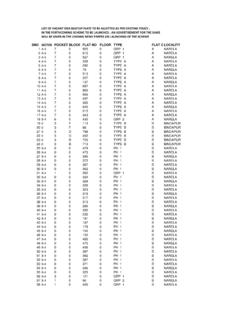
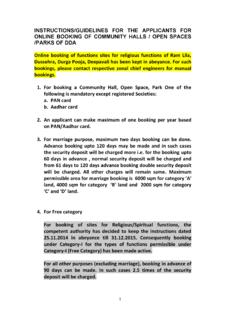
![[TELEPHONE DIRECTORY] Name & Designation नाम एवं …](/cache/preview/3/9/6/2/3/a/d/d/thumb-39623add0ae11cb3a44d43b7f43f1d7c.jpg)
